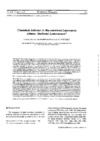Identificador persistente para citar o vincular este elemento:
https://accedacris.ulpgc.es/handle/10553/794
| Campo DC | Valor | idioma |
|---|---|---|
| dc.contributor.author | Granado Reyes, Inmaculada | en_US |
| dc.contributor.author | Caballero Ortega, Pascual | en_US |
| dc.contributor.other | Facultad de Ciencias del Mar | - |
| dc.contributor.other | Departamento de Biología | - |
| dc.date.accessioned | 2009-10-08T02:31:00Z | - |
| dc.date.accessioned | 2018-03-01T13:40:30Z | - |
| dc.date.available | 2018-03-01T13:40:30Z | - |
| dc.date.issued | 1995 | en_US |
| dc.identifier.isbn | 2148358 | - |
| dc.identifier.issn | 0214-8358 | en_US |
| dc.identifier.other | 1685 | - |
| dc.identifier.uri | https://accedacris.ulpgc.es/handle/10553/794 | - |
| dc.description.abstract | The marine red alga Laurencia obtusa is a low preference food for the herbivorous gastropods Littorina striata and Osilinus atratus, when offered in the presence of Enteromorpha ramulosa or Ulva rigida, in laboratory assays using the agar suspension method. Neither nitrogen content nor total and available caloric contents could explain this low preference. L. obtusa produces secondary metabolites that can lower its palatability to herbivores. The low susceptibility to grazing by snails in these species of algae seems to be associated with the presence of these secondary metabolites. Feeding by Osilinus was significantly inhibited by crude extract, non-polar and polar fractions of Laurencia. The polar fraction did not deter feeding by Littorina. Some of the pure metabolites (elatol, isobtusol, and obtusol) isolated from the non-polar fraction of L. obtusa significantly reduced feeding by both snails. In contrast, obtusane significantly diminished grazing by Osilinus but not by Littorina. To test whether extracts and individual terpenes were toxic on non-grazer species; their effects on survival of fish larvae (Sparus aurata) were analyzed. Elatol was the most effective in producing the death of larvae, while obtusane was not active at the used concentrations. | en_US |
| dc.language | eng | en_US |
| dc.relation.ispartof | Scientia Marina | en_US |
| dc.source | Scientia Marina. v. 59 (Supl.1), pp. 31-39 | en_US |
| dc.subject | 241705 Biología marina | en_US |
| dc.subject.other | Ecología marina | en_US |
| dc.subject.other | Metabolitos marinos | en_US |
| dc.subject.other | Efectos fisiológicos | en_US |
| dc.title | Chemical defense in the seaweed Laurencia obtusa (Hudson) Lamoroux | en_US |
| dc.type | info:eu-repo/semantics/article | en_US |
| dc.type | Article | en_US |
| dc.relation.conference | VIII Iberian Symposium on Marine Benthos Studies | - |
| dc.identifier.isi | A1995TY23000005 | - |
| dc.contributor.contentdm | Facultad de Ciencias del Mar | - |
| dc.contributor.contentdm | Organismos, poblaciones y ecosistemas | - |
| dc.contributor.contentdm | Biología | - |
| dc.identifier.absysnet | 225152 | - |
| dc.identifier.crisid | - | - |
| dc.identifier.eissn | 1886-8134 | - |
| dc.description.lastpage | 39 | en_US |
| dc.description.firstpage | 31 | en_US |
| dc.relation.volume | 59 | en_US |
| dc.investigacion | Ciencias | en_US |
| dc.rights.accessrights | info:eu-repo/semantics/openAccess | - |
| dc.type2 | Artículo | en_US |
| dc.contributor.daisngid | 28217864 | - |
| dc.contributor.daisngid | 2725442 | - |
| dc.description.numberofpages | 9 | en_US |
| dc.utils.revision | Sí | en_US |
| dc.contributor.wosstandard | Facultad de Ciencias del Mar | - |
| dc.contributor.wosstandard | Organismos, poblaciones y ecosistemas | - |
| dc.contributor.wosstandard | Biología | - |
| dc.contributor.wosstandard | WOS:Granado, I | - |
| dc.contributor.wosstandard | WOS:Caballero, P | - |
| dc.date.coverdate | Diciembre 1995 | en_US |
| dc.identifier.supplement | - | - |
| dc.identifier.supplement | 1 | - |
| dc.identifier.ulpgc | Sí | en_US |
| dc.description.scie | SCIE | |
| item.grantfulltext | open | - |
| item.fulltext | Con texto completo | - |
| Colección: | Artículos | |
Los elementos en ULPGC accedaCRIS están protegidos por derechos de autor con todos los derechos reservados, a menos que se indique lo contrario.
